Synopsis
Movement I: Ocean's Kingdom
The Princess Honorata lives with her father, King Ocean, in an underwater kingdom. In charge of her handmaidens is the somewhat sinister character Scala. Their idyllic existence is one day interrupted by intruders from the earthly kingdom, ruled by King Terra. He arrives with his band of aggressive followers and his younger brother Prince Stone. They are there to deliver an invitation to a grand ball. Prince Stone begins to fall in love with Princess Honorata.
Movement II: Hall of Dance
Guests arrive at the grand Hall of Dance and are treated to a spectacle of acrobatic dancing. Wandering through their midst are three drunken lords. King Ocean and Honorata arrive and, once again, encounter King Terra's unruly retinue. The attraction between Stone and Honorarta becomes stronger as the rivalry between the dancers becomes more intense. At the end of the dance, unnoticed by Prince Stone and King Ocean, Honorata is kidnapped by King Terra, who secretly desires her himself, and his henchmen by the aid of the treacherous Scala.
Movement III: Imprisonment
Princess Honorata despairs of her fate as she is seen imprisoned in Terra's run-down palace. Prince Stone arrives, furious at Terra's actions and Scala's betrayal. He demands Honorata's release but is rebuffed by Terra. Scala realizes she was wrong to turn against her mistress and promises to aid Prince Stone with Honorata's release. The two lovers are reunited and fall into a passionate embrace before escaping.
Movement IV: Moonrise
As the moon rises outside Terra's palace, Scala, Honorata and Stone escape into the night. They are soon pursued by Terra and his warriors. Against the wishes of the lovers, Scala turns back to stop the advancing army, and though she is ignored by them she magically conjures up a storm which envelopes and destroys them. To the horror of Honorata and Stone, Scala also perishes. They escape and are met by friendly forces from the Ocean Kingdom. They return home in triumph and as the celebrations subside and the lovers are left alone, the spirit of Scala makes a final appearance to bless their union.
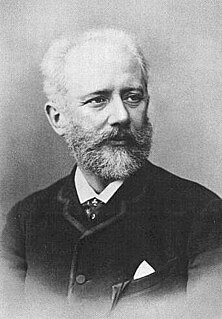
Swan Lake, Op. 20, is a ballet composed by Russian composer Pyotr Ilyich Tchaikovsky in 1875–76. Despite its initial failure, it is now one of the most popular ballets of all time.
Cinderella Op. 87, is a ballet composed by Sergei Prokofiev to a scenario by Nikolai Volkov. It is one of his most popular and melodious compositions, and has inspired a great many choreographers since its inception. The piece was composed between 1940 and 1944. Part way through writing it Prokofiev broke off to write his opera War and Peace. The premiere of Cinderella was conducted by Yuri Fayer on 21 November, 1945, at the Bolshoi Theatre, with choreography by Rostislav Zakharov and Galina Ulanova in the title role. Cinderella is notable for its jubilant music, lush scenery, and for the comic double-roles of the stepmother and the two stepsisters, more mad than bad in this treatment.
The Pharaoh's Daughter, is a ballet choreographed by Marius Petipa to music by Cesare Pugni. The libretto was a collaboration between Jules-Henri Vernoy de Saint-Georges and Petipa from Théophile Gautier's Le Roman de la momie. It was first presented by the Imperial Ballet at the Imperial Bolshoi Kamenny Theatre, in St. Petersburg, Russia, on 18 January 1862, with the design by A. Roller, G. Wagner (scenery), Kelwer and Stolyakov (costumes).

Xcalibur is a French Canadian CGI sword-and-sorcery children's television series that aired on YTV from 1 September 2001 to 1 April 2002.

The Sleeping Beauty is a ballet in a prologue and three acts, first performed in 1890. The music was composed by Pyotr Ilyich Tchaikovsky. The score was completed in 1889, and is the second of his three ballets. The original scenario was conceived by Ivan Vsevolozhsky, and is based on Charles Perrault's La Belle au bois dormant. The choreographer of the original production was Marius Petipa.

Prince Gabriel Constantinovich of Russia was the second son of Grand Duke Konstantin Konstantinovich of Russia and his wife, Grand Duchess Elizabeth Mavrikievna of Russia. A great-grandson of Tsar Nicholas I, he was born in Imperial Russia and served in the army during World War I. He lost much of his family during the war and the Russian Revolution. He narrowly escaped execution by the Bolsheviks and spent the rest of his life living in exile in France.

Ibong Adarna is a 16th-century Filipino epic poem. It is about an eponymous magical bird. The longer form of the story's title during the Spanish era was "Korido at Buhay na Pinagdaanan ng Tatlong Prinsipeng Magkakapatid na anak ni Haring Fernando at ni Reyna Valeriana sa Kahariang Berbanya", and is believed by some researchers to have been based on similar European stories. The tale is also known as The Aderna Bird.

Barbie in the Nutcracker is a 2001 computer-animated film directed by Owen Hurley. It was released to video on October 23, 2001, and made its television premiere on Nickelodeon on March 21, 2004.
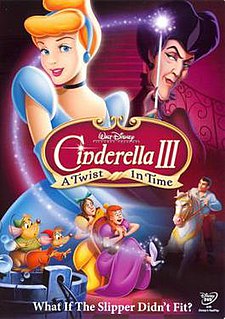
Cinderella III: A Twist in Time is a 2007 American direct-to-video fantasy adventure film. It is directed by Frank Nissen and features a screenplay by Dan Berendsen, Margaret Heidenry, Colleen Ventimilia, and Eddie Guzelian. It is the second direct-to-video sequel to the 1950 Walt Disney Pictures animated film Cinderella and third and final installment in the Cinderella trilogy. The film features the voices of Jennifer Hale and Susanne Blakeslee as Cinderella and Lady Tremaine respectively. It made its world television premiere on Toon Disney on December 3, 2007.
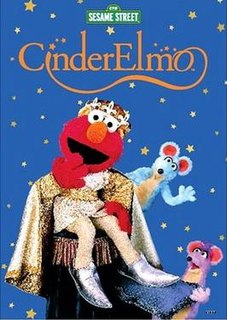
CinderElmo is a 65-minute television film that aired on Fox in the United States on December 6, 1999. It was released on VHS and DVD in North America on February 29, 2000.
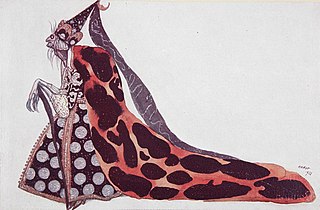
The Wicked Fairy Godmother or the Wicked Fairy, a rare figure in fairy tales, is nevertheless among the best-known figures from such tales because of her appearance in one of the most widely known tales, Sleeping Beauty, and in the ballet derived from it. Anonymous in her first appearance, she was later named in some variants Carabosse and is called Maleficent in Walt Disney media.
Le Talisman is a ballet in 4 Acts and 7 Scenes, with choreography by Marius Petipa, and music by Riccardo Drigo. Libretto by Konstantin Augustovich Tarnovsky and Marius Petipa. It was premièred on February 6 [O.S. January 25] 1889 at the Imperial Mariinsky Theatre in St. Petersburg, Russia This ballet gave rise to the so-called Talisman Pas de Deux, which is today danced by many ballet companies.

Cinderella is a ballet-féerie in three acts, with the choreography of Enrico Cecchetti and Lev Ivanov supervised by Marius Petipa. Music is by Baron Boris Fitinhoff-Schell; the libretto is by Lidia Pashkova and Ivan Vsevolozhsky. It was first presented by the Imperial Ballet on 17 December [O.S. 5 December] 1893 at the Imperial Mariinsky Theatre in St. Petersburg, Russian Empire.
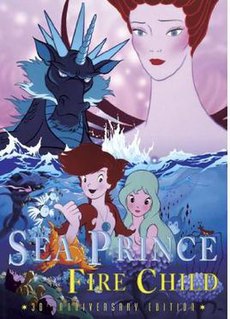
The Sea Prince and the Fire Child is a 1981 Japanese anime film by Sanrio, based on a story by Shintaro Tsuji. It is said to be a loose retelling of Romeo and Juliet, itself a European version of many tales of star-crossed lovers in a variety of cultures and eras. In this story, the children of the gods of fire and water fall in love and fight to stay together in the face of adversity.
Leonce and Lena is a play by Georg Büchner (1813–1837) which is considered a comedy, but is actually a satire veiled in humor. It was written in the spring of 1836 for a competition 'for the best one- or two-act comedy in prose or verse' sponsored by the Stuttgart publisher Cotta. However, Büchner missed the submission deadline and the play was returned to him unread. It was premiered almost 60 years later, on May 31, 1895, in an outdoor performance by the Munich Company Intimes Theater, directed by Ernst von Wolzogen and with the involvement of Max Halbe and Oskar Panizza, illustrating the fact that Büchner only gained prominence as a writer in the 20th century.

The Princess' Man is a 2011 South Korean television series, starring Park Si-hoo, Moon Chae-won, Kim Yeong-cheol, Song Jong-ho, Hong Soo-hyun and Lee Soon-jae. It's a period drama about the forbidden romance between the daughter of Grand Prince Suyang and the son of Kim Jong-seo, Suyang's political opponent. It aired on KBS2 from July 20 to October 6, 2011, on Wednesdays and Thursdays at 21:55 for 24 episodes.

Flora, Fauna, and Merryweather are the three good fairies in Walt Disney's 1959 film Sleeping Beauty. They are characterized as Princess Aurora's fairy godmothers and guardians, who appear at baby Aurora's christening to present their gifts to her. The three were voiced by Verna Felton, Barbara Jo Allen, and Barbara Luddy, respectively.
The Magic Mirror is a ballet-féerie in four acts and seven scenes, originally choreographed by Marius Petipa with music by Arseny Koreshchenko. The libretto is based on the 1812 fairy tale Snow White by the Brothers Grimm and the 1833 poem The Tale of the Dead Princess and the Seven Knights by Alexander Pushkin. The ballet was premièred on the 22 February [O.S. 9 February] 1903 at the Imperial Mariinsky Theatre in St. Petersburg, Russia.











